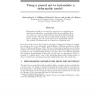3053 search results - page 600 / 611 » Performance of Generative Programming Based Protocol Impleme... |
NIPS
1994
13 years 9 months ago
1994
Deformable models are an attractive approach to recognizing nonrigid objects which have considerable within class variability. However, there are severe search problems associated...
BMCBI
2006
13 years 7 months ago
2006
Background: Understanding gene regulatory networks has become one of the central research problems in bioinformatics. More than thirty algorithms have been proposed to identify DN...
JCB
2006
13 years 7 months ago
2006
A commonly used tool in disease association studies is the search for discrepancies between the haplotype distribution in the case and control populations. In order to find this d...
BMCBI
2006
13 years 7 months ago
2006
Background: We recently developed the Paired End diTag (PET) strategy for efficient characterization of mammalian transcriptomes and genomes. The paired end nature of short PET se...
BMCBI
2007
13 years 7 months ago
2007
Background: The p53 gene family consists of the three genes p53, p63 and p73, which have polyhedral non-overlapping functions in pivotal cellular processes such as DNA synthesis a...

